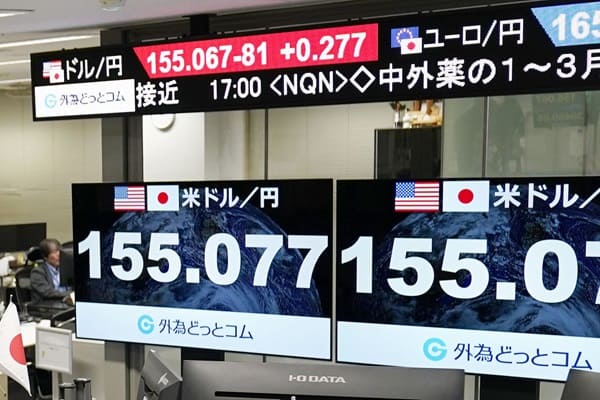Bussiness
The future of USD/JPY: Japan’s economic recovery tests market stability – London Business News | Londonlovesbusiness.com

The USD/JPY pair has experienced a significant rise during recent trading sessions, opening Tuesday’s session at 150.968, its highest level in two days. This increase is primarily due to the overall weakness of the Japanese yen, reflecting growing scepticism among investors regarding the Bank of Japan’s (BoJ) intention to raise interest rates in its upcoming December 19 meeting.
Despite Japan’s strong economic performance in the third quarter, the market appears cautious about the central bank’s willingness to take bold steps in monetary policy. I interpret this as a sign of the structural challenges in Japan’s economic strategy.
Japan’s annualized economic growth of 1.2% in the third quarter, compared to 0.9% in the previous quarter, demonstrates notable improvement and exceeds analysts’ expectations. However, from my perspective, this momentum has not been sufficient to dispel concerns about the BoJ’s future direction.
While growth is accelerating, Japan continues to grapple with persistently low inflation and labour market challenges. These factors lead me to believe that the BoJ may extend its cautious policy stance longer than traders anticipate, prioritizing economic stability over risking market confidence.
Upcoming economic data will be a key driver for the USD/JPY pair’s movements. Investors are closely monitoring Japan’s Producer Price Index (PPI) data for November, which may offer fresh insights into inflationary pressures.
Strong PPI data could bolster expectations of an interest rate hike, whereas a slowdown might reinforce the yen’s weakness. In my view, economic data remains a critical yet limited factor unless accompanied by decisive actions from the BoJ to restore market confidence.
On the other side of the equation, U.S. inflation data due on Wednesday is also in the spotlight. This data is expected to play a pivotal role in shaping the Federal Reserve’s monetary policy trajectory, particularly as market expectations align with a potential rate cut to 4.25%-4.50% at its upcoming meeting.
If the inflation figures fall below expectations, it could increase the likelihood of a rate cut, potentially weakening the dollar and temporarily strengthening the yen. However, I believe such effects may be short-lived, as the yen remains fundamentally constrained by domestic factors.
Based on these dynamics, I anticipate that the future of the USD/JPY pair will hinge on forthcoming economic and policy developments from both sides.
While the dollar may face downward pressure from potential U.S. rate cuts, the yen remains under strain due to market doubts about the BoJ’s policy stance. Consequently, the pair will likely remain in a narrow trading range in the short term, with the upward trend persisting if the BoJ fails to instil greater confidence among investors.
The USD/JPY pair is currently trading within a narrow range near the 150 level, exhibiting a strong tendency for selling at higher levels. On the daily chart, bearish momentum remains evident, with the Relative Strength Index (RSI) steady in neutral territory.
Key support levels are presently situated at 149.50 and 148.80, which align with the 100-day moving average, followed by a critical support level at 148.20, based on the 38.2% Fibonacci retracement from September’s low to November’s high.
On the resistance side, levels are seen between 151.30 and 151.82, corresponding to the 50-day moving average, with stronger resistance at 152, the 200-day moving average. These technical levels suggest a balanced yet cautious outlook, where market movements will likely hinge on breaking either the support or resistance zones, dictating the next directional move.
Next week’s Bank of Japan (BoJ) meeting is expected to be a pivotal moment for guiding the yen’s movements. Recent economic indicators, including improved Q3 GDP growth and a rise in core wages, support expectations for gradual monetary policy tightening. While projections suggest continued rate hikes through 2025, the pace of this tightening could significantly impact the markets, especially if it falls short of expectations.
Simultaneously, U.S. economic data plays a critical role in shaping USD/JPY movements. With the Federal Reserve likely to begin cutting interest rates in the coming months, the dollar may face additional downward pressure. However, if the Fed delays easing monetary policy, intermittent upward pressure on the pair could emerge. Focus will also remain on the U.S. Producer Price Index (PPI) data and Japan’s Tankan Survey, which may provide further directional signals.
Based on these dynamics, USD/JPY is likely to remain volatile, with a bearish bias. A break below the 149.50 support level could pave the way for a deeper correction toward 148.20. Conversely, a breach of the 152 resistance level may bolster short-term bullish momentum. The overall trend will remain subject to changes in monetary policy decisions from both central banks and upcoming economic developments.
Support Levels: 150.948 – 150.511 – 149.779
Resistance Levels: 151.824 – 152.261 – 152.993










